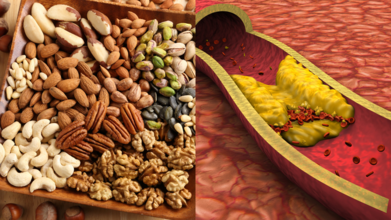- Health Conditions A-Z
- Health & Wellness
- Nutrition
- Fitness
- Health News
- Ayurveda
- Videos
- Medicine A-Z
- Parenting
- Web Stories
What No One Tells You About High Insulin And Weight Gain- What It Means?

Image Credit: Canva
Like most people, when I gained weight I couldn’t figure it out initially. I was eating the same, exercising, even cutting back on sweets—but the scale kept creeping up. My clothes felt tighter, my energy dipped, and frustration took over. Was it stress? Hormones? I felt like my own body was betraying me, and I had no answers.
Insulin is one of approximately 50 hormones that regulate essential biological functions in the body. Produced by the pancreas, its primary role is to control blood sugar levels. However, when insulin levels become too high—a condition known as hyperinsulinemia—it can contribute to weight gain and set the stage for prediabetes and type 2 diabetes.
To fully grasp the impact of high insulin levels, it's important to understand how this hormone functions. When you eat, your body converts carbohydrates into glucose (blood sugar). Insulin then helps transport this glucose from the bloodstream into cells, where it is used for energy. If glucose levels remain persistently high, the body responds by producing extra insulin. Over time, this can lead to insulin resistance, weight gain, and a higher risk of metabolic disorders.
Connection Between High Insulin and Weight Gain
Many people assume that weight gain is simply a result of overeating and lack of exercise. While those factors play a role, high insulin levels are often an overlooked contributor.
When your body becomes insulin resistant, it requires more insulin to regulate blood sugar levels. This excess insulin signals the body to store fat rather than burn it for energy. As a result, instead of glucose being utilized efficiently, it is stored in fat cells—leading to gradual and persistent weight gain.
Moreover, insulin resistance can disrupt hunger signals, causing increased cravings for carbohydrates and sugar. This creates a vicious cycle where high insulin levels promote further weight gain, making it harder to maintain a healthy metabolism.
Signs and Symptoms of High Insulin Levels
Unlike high blood sugar, high insulin levels do not always produce immediate symptoms. However, chronic high insulin can lead to noticeable signs associated with high blood sugar, including:
- Frequent urination
- Increased thirst
- Blurred vision
- Persistent fatigue
- Heightened hunger and cravings
If you experience any of these symptoms, it's important to consult a healthcare provider for further evaluation.
What Causes Insulin Resistance?
Insulin resistance occurs when muscle, fat, and liver cells stop responding properly to insulin, forcing the pancreas to produce even more. Several factors can contribute to this condition, including:
Poor Diet Choices: High consumption of refined carbohydrates, sugars, and processed foods can lead to insulin spikes and resistance over time.
Sedentary Lifestyle: Lack of physical activity reduces the body's ability to utilize glucose efficiently, leading to increased insulin demand.
Excess Belly Fat: Obesity, particularly excess fat around the abdomen, is strongly linked to insulin resistance.
Genetic Predisposition: A family history of diabetes or metabolic disorders increases the risk.
Hormonal Imbalances: Conditions such as polycystic ovary syndrome (PCOS) and stress-related cortisol spikes can contribute to insulin resistance.
Aging: As the body ages, insulin sensitivity naturally declines, making weight management more challenging.
How to Prevent and Reverse High Insulin Levels
The good news is that insulin resistance can often be managed or even reversed through lifestyle changes. Here’s how:
1. Adopt a Low-Glycemic Diet
Foods with a high glycemic index (GI), such as white bread, sugary snacks, and processed foods, cause rapid spikes in blood sugar and insulin. Instead, focus on:
Healthy fats (avocados, nuts, olive oil)
Fiber-rich foods (leafy greens, legumes, whole grains)
2. Engage in Regular Physical Activity
Exercise plays a crucial role in improving insulin sensitivity. Activities like strength training, brisk walking, and high-intensity interval training (HIIT) help muscles use glucose efficiently, reducing insulin levels over time.
3. Manage Stress Levels
Chronic stress leads to elevated cortisol levels, which can contribute to insulin resistance. Practices such as yoga, meditation, and deep breathing exercises can help regulate stress and improve insulin function.
4. Prioritize Sleep
Poor sleep disrupts insulin regulation and increases cravings for high-sugar foods. Aim for at least 7-9 hours of quality sleep per night to support metabolic health.
5. Consider Medical Testing and Intervention
If you suspect high insulin levels, consult a healthcare provider for proper testing. Blood tests, such as fasting insulin levels and oral glucose tolerance tests, can determine your risk for insulin resistance or prediabetes. In some cases, medications like Metformin may be prescribed to help regulate blood sugar and insulin levels.
Other Causes of High Insulin Levels
While insulin resistance is the most common cause of high insulin, other medical conditions can contribute, including:
Insulinomas: Rare pancreatic tumors that cause excessive insulin production.
Nesidioblastosis: A condition in which the pancreas produces too many insulin-producing cells.
Hormonal Disorders: Conditions like Cushing’s syndrome and acromegaly can disrupt insulin function.
If you experience unexplained low blood sugar symptoms—such as dizziness, irritability, or fainting—seek medical attention to rule out underlying conditions.
Importance of Early Detection
Many people with insulin resistance or prediabetes remain undiagnosed because symptoms often go unnoticed. According to the National Institutes of Health, nearly one in three adults in the U.S. has prediabetes, yet most are unaware of their condition.
Regular screenings, such as fasting blood sugar tests and hemoglobin A1C tests, can help detect issues early and prevent progression to type 2 diabetes. If you have a family history of diabetes or other risk factors, it’s crucial to get tested regularly.
High insulin levels and insulin resistance are not just precursors to diabetes—they can significantly impact weight, energy levels, and overall well-being. By making informed dietary choices, staying active, managing stress, and prioritizing regular medical check-ups, you can take control of your insulin health and prevent long-term complications.
If you suspect insulin resistance, don’t wait—seek professional guidance and start making changes today. Your health depends on it.
A 4-Step Science-Backed Routine That Works for Every Skin Type

There was a time when skincare felt like a competitive sport. People layered acids, scrubbed their faces raw, and measured success in stings, peels, and redness. But times are changing. A new, science-backed wave is sweeping in, one that values results without leaving your skin feeling like it has been through a survival reality show.
From Shelf Overload to Skincare Simplicity
For years, we’ve been told more is better. More products, more steps, more actives, until our bathroom shelves looked like mini-pharmacies. But skin, much like us, thrives in balance. Aggressive routines may deliver quick wins, but they often come with side effects like irritation, dryness, or breakouts that weren’t invited to the party.The modern approach is a gentler, more measured one: using well-formulated products that are kind to the skin barrier but still pack enough punch to make a visible difference. And the best part? You only need a few steps, not a 12-item shopping list.
The Four Steps That Actually Work
Malini Adapureddy, Founder of Deconstruct Skincare, swears by a routine that’s simple enough to remember before coffee and effective enough to see results in weeks. Designed for Indian skin and climate, this four-step method covers the essentials: cleansing, treating, moisturising, and protecting.
Step 1: The Clean Slate
Every story starts somewhere, and for your skin, that’s cleansing. But the goal isn’t to strip your face like it’s a frying pan that’s just seen a masala spill. A gentle oil-control face wash with salicylic acid and niacinamide is the ticket. Salicylic acid slips into pores to keep them clear, while niacinamide calms and balances.Step 2: The Targeted Glow Shot
Once the canvas is prepped, it’s time for the serum stage. Enter a 10% vitamin C serum with 0.5% ferulic acid. Vitamin C is your radiance best friend, helping to fade pigmentation and even out skin tone, while ferulic acid boosts its stability and antioxidant power. Together, they help defend against environmental stressors and bring your complexion back from the land of dull.Unlike some actives that feel like they’re burning through your soul, this combination is gentle enough for daily use.
Step 3: The Barrier Hug
Moisturiser is often seen as the “optional” step, especially if you have oily skin. But hydration isn’t just about adding water; it’s about locking it in. A lightweight, oil-free moisturiser with natural moisturising factors (NMF) and panthenol keeps your skin barrier happy. It helps reduce sensitivity, supports repair, and works in harmony with your actives. And in India’s hot, humid, sometimes dusty climate, that’s a much-needed shield.Step 4: The Non-Negotiable
Sunscreen. Always sunscreen. Whether you’re outside chasing errands or inside chasing deadlines, UV damage is sneaky. It causes pigmentation, speeds up ageing, and undoes all the hard work your serum and moisturiser put in. A broad-spectrum, gel-based sunscreen keeps things light, non-greasy, and comfortable, even under makeup.Why Gentle Works Better Than You Think
There’s a myth that 'strong' means 'effective'. In reality, harsh products can damage your skin barrier, leaving it inflamed and reactive. Gentle formulations, when done right, work gradually but deeply. They’re like the friend who doesn’t shout advice but still changes your life.Consistency is the secret here. When your skin isn’t constantly fighting irritation, it can focus on repairing itself, building resilience, and looking better over time.
What Is Pulmonary Fibrosis and Why That Annoying Cough Might Be More Than Just a Cold

Credits: Canva
If you’ve been coughing for weeks, blaming it on “lingering winter sniffles” or chalking it up to “just getting older,” it might be time to step away from the cough syrup and lean in for some uncomfortable truth. Your cough could be more than a seasonal annoyance. In rare but serious cases, it could be a red flag for a life-limiting condition called pulmonary fibrosis.
What is Pulmonary Fibrosis?
In plain terms, “pulmonary” means lungs, and “fibrosis” means scarring. It’s a serious, progressive condition where lung tissue becomes scarred and stiff, making it increasingly hard to breathe.
Reportedly, there’s currently no cure. Treatments exist, but they mainly slow down the damage rather than reverse it. The sooner you get diagnosed, the better your chances of managing symptoms and that’s where spotting the signs early is crucial.
Symptoms to Watch For
- Shortness of breath (especially when climbing stairs or speed-walking to catch the bus)
Why That Cough Happens
Coughing is your body’s bouncer, booting out anything that might harm your lungs — dust, smoke, rogue crumbs, the works. The process involves your vocal cords clamping shut, then snapping open with a burst of air.
With pulmonary fibrosis, this reflex can get stuck on a loop. Coughing irritates the vocal cords, which makes you cough more, which irritates them further, a vicious cycle that can turn even a quiet cup of tea into a coughing fit.
The Four Flavours of Cough
- Acute cough – Lasts less than three weeks; often tied to infections or irritants.
Coughs can also be:
- Dry/unproductive – Triggered by things like temperature changes, dusty air, or laughing.
Who’s More at Risk?
While pulmonary fibrosis can happen to anyone, your risk might be higher if you:
- Are over 50
Managing the Cough
A pulmonary fibrosis cough often doesn’t respond to standard cough medicines. Instead, treatment usually focuses on easing symptoms and improving quality of life.
Your doc may recommend alternative medications used for chronic cough in other conditions. These don’t cure the scarring but can make the coughing less intrusive. They’ll also want to check for other contributing factors like acid reflux, sinus issues, or side effects from medication, because if those are making things worse, tackling them can help.
Everyday Coping Tricks
While you work with your doctor, you can try a few lifestyle tweaks to manage coughing fits:
- Avoid smoky, dusty, or heavily polluted spaces
Pulmonary fibrosis is rare, but catching it early can mean more treatment options and better management. Plus, you’ll finally know whether your cough is from a stubborn cold or something that needs closer attention. Your cough could be a harmless side effect of a dusty ceiling fan or it could be your body waving a red flag.
Scientist Reveals the Tiny Foods That Can Transform Your Cholesterol in Just 10 Days

If you’ve ever stared at a packet of mixed nuts wondering whether to sprinkle them over your porridge or just eat them by the handful, here’s your permission slip: go for it. According to Dr Sarah Berry, a professor at King’s College London and Chief Scientist at ZOE, nuts and seeds are not just snackable; they are good for cholesterol crunching. In fact, swap some of your less healthy fats for these nutritional powerhouses, and you could lower your cholesterol by up to 10 per cent in just 10 days. That is faster than most fad diets.
The 10-Day Cholesterol Challenge
High cholesterol often feels like one of those invisible problems, until it suddenly is not. It can quietly build up in your arteries, increasing the risk of heart attacks and strokes. But Dr Berry, during an appearance on the Zoe podcast, said that you can make a real difference in under two weeks by tweaking, not overhauling, your diet. It’s not about eating less fat; it’s about eating the right kind of fat.
And this is where most people get it wrong. “Don’t do a low-fat diet,” Dr Berry warns, calling the idea “radical” to anyone still following decades-old advice. Instead, aim for a moderate-fat diet rich in polyunsaturated and monounsaturated fats—exactly the kinds you’ll find in nuts, seeds, and certain oils.
Why Low-Fat Diets Miss the Point
It is tempting to think cutting fat will cut cholesterol, but Dr Berry explains that’s a trap. Not all fats are bad. Saturated fats, found in red meat and some processed foods, can push LDL cholesterol—often dubbed “bad” cholesterol—into dangerous territory. But polyunsaturated fats, abundant in seeds, seed oils, and many nuts, do the opposite.
Simply adding nuts to your meals, whether as a snack, salad topping, or nut butter, can slash LDL cholesterol by 5 to 10 per cent. You have to make a swap. This benefit comes from replacing “harmful” fats, like those in certain animal products and fried foods, with healthier plant-based fats.
Seeds: The Cholesterol Fighters
Sunflower seeds, flaxseeds, chia seeds—they’re all loaded with polyunsaturated fatty acids that support heart health. Stir them into yoghurt, blend them into smoothies, or scatter them over roasted veggies. You’ll barely notice the extra effort, but your arteries will thank you.
Seed oils, like sunflower and flaxseed oil, can also be smart choices in moderation, adding healthy fats to your cooking without the cholesterol-raising impact of certain animal fats.
Rethinking Dairy, Meat, and Carbs
Dr Berry isn’t out to demonise all animal products. Fermented dairy like yoghurt and cheese gets a surprising green light. These foods, she says, don’t have the cholesterol-raising effect you might expect from their saturated fat content. That’s not permission to live on brie and cheddar, but it is a reason to stop fearing your cheese board.
Red meat, however, is a different story. Packed with saturated fats, it’s a direct contributor to rising cholesterol levels. Swapping steak nights for lentil stews or chickpea curries a couple of times a week could make a noticeable difference to your numbers.
Then there’s the carbohydrate conundrum. The real trouble lies with refined carbs like white bread, white rice, and sugary snacks. These are rapidly processed by your body and can be converted into triglycerides, which worsen cholesterol profiles. But whole grains are firmly in the “good for you” column. Wholegrain bread, brown rice, oats, and quinoa can help improve cholesterol levels when they replace the refined stuff.
Building Your 10-Day Cholesterol Menu
Swap your morning white toast for porridge topped with walnuts and chia seeds. Your mid-morning biscuit could become a small handful of almonds. At lunch, toss sunflower seeds into your salad, and use olive or sunflower oil for dressing. Dinner might feature grilled salmon or chickpeas instead of steak, with a side of quinoa instead of white rice.
Why This Works So Fast
Cholesterol levels can be surprisingly responsive to dietary changes. LDL cholesterol particles are constantly being produced and cleared from your bloodstream. When you replace saturated fats with healthier fats, you improve your body’s ability to remove LDL cholesterol. Combine that with reducing refined carbs and upping your wholegrain intake, and the improvement can be measurable in just days.
Dr Berry’s advice is refreshingly realistic: no calorie counting, no extreme restrictions, just sensible swaps. It’s about building habits you can maintain beyond the initial 10 days, keeping your cholesterol low for the long haul.
Forget the idea that lowering cholesterol means bland food and joyless salads. With nuts, seeds, and the right fats, you can eat deliciously and still give your heart a health boost in record time.
© 2024 Bennett, Coleman & Company Limited

